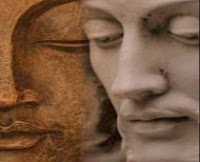
What keeps us from enlightenment and nirvana? The flood of taints (asavas, outflows).*
- The Buddhist. To be a "Buddhist" one need only do two things.
 The first is go for guidance (sarana) to the Three Jewels, namely, the Buddha, Dharma, and Sangha. The Buddha is one's own enlightened nature or capacity for enlightenment. The Dharma is the teaching of an enlightened one; it really represents an existing reality, the way things truly are beyond our biases and conceptions. The Doctrine is merely a reflection of it. So whereas the Doctrine (Buddha-Dharma) will become corrupted and fade away, the Truth it represents is completely imperishable. It will be there to be rediscovered by those who in the future manage to cultivate the perfections (paramis). The Sangha is not the monastics in saffron robes. Like the Doctrine, they represent the Sangha. But the Sangha really means the enlightened or accomplished or Noble (arya) Sangha, whether ordained or not. So the Three Jewels (also called the Triple Gem) are the Teacher, the Teaching, and the Taught. The three represent the Enlightened One, the Enlightening Doctrine, and the well-instructed Enlightened Disciples. The second thing is wanting to be a Buddhist, and one need not leave one's faith or cultural traditions to go for guidance or to follow that guidance.
The first is go for guidance (sarana) to the Three Jewels, namely, the Buddha, Dharma, and Sangha. The Buddha is one's own enlightened nature or capacity for enlightenment. The Dharma is the teaching of an enlightened one; it really represents an existing reality, the way things truly are beyond our biases and conceptions. The Doctrine is merely a reflection of it. So whereas the Doctrine (Buddha-Dharma) will become corrupted and fade away, the Truth it represents is completely imperishable. It will be there to be rediscovered by those who in the future manage to cultivate the perfections (paramis). The Sangha is not the monastics in saffron robes. Like the Doctrine, they represent the Sangha. But the Sangha really means the enlightened or accomplished or Noble (arya) Sangha, whether ordained or not. So the Three Jewels (also called the Triple Gem) are the Teacher, the Teaching, and the Taught. The three represent the Enlightened One, the Enlightening Doctrine, and the well-instructed Enlightened Disciples. The second thing is wanting to be a Buddhist, and one need not leave one's faith or cultural traditions to go for guidance or to follow that guidance.
2. The good Buddhist. To be a good Buddhist one need only do three things, the first two just mentioned and uphold the Five Precepts.
 What guidance does the Three-faceted Gem give? It teaches the Four Noble Truths, the fourth truth being the Noble Eightfold Path. That is the teaching that leads to enlightenment. But to read it, it all sounds very general. It is not obvious. It needs unpacking. All eight arms open up to very well defined factors. For example, "right effort" does not mean putting in what you call effort then calling it a day. No, right effort has an exact meaning: the effort to abandon unwholesome states, to cultivate wholesome ones, to maintain them, and to bring them to fullness. What are the Five Precepts? They are the minimum of decency and humanity and are not limited to Buddhism -- abstaining from killing, stealing, sexual misconduct, false speech, and intoxication occasioning to heedlessness. (All of these factors are also precisely defined leaving no need to interpret and invent biased definitions).
What guidance does the Three-faceted Gem give? It teaches the Four Noble Truths, the fourth truth being the Noble Eightfold Path. That is the teaching that leads to enlightenment. But to read it, it all sounds very general. It is not obvious. It needs unpacking. All eight arms open up to very well defined factors. For example, "right effort" does not mean putting in what you call effort then calling it a day. No, right effort has an exact meaning: the effort to abandon unwholesome states, to cultivate wholesome ones, to maintain them, and to bring them to fullness. What are the Five Precepts? They are the minimum of decency and humanity and are not limited to Buddhism -- abstaining from killing, stealing, sexual misconduct, false speech, and intoxication occasioning to heedlessness. (All of these factors are also precisely defined leaving no need to interpret and invent biased definitions).
3. The great Buddhist. To be a great Buddhist one need only do four things, the three just mentioned and meditate successfully.
 How is one to learn the definitions of all the factors just mentioned? One studies the Dharma and goes for guidance to the Sangha. In this case those in saffron robes become very handy. They preserve and teach the Dharma. Like the Kalama Sutra advises, don't simply take their word for it. Look into it, investigate, read and reason and reflect. But don't merely reason. The path was not arrived at by mere reasoning. It took a supremely enlightened buddha to rediscover exactly because it is not obvious, not attainable by reasoning, not -- like Einstein said -- solvable from the level of the problem. The problem is suffering (dukkha, unhappiness of all kinds) and the cause of suffering. The solution is nirvana and the Noble Eightfold Path. How does one meditate successfully? Read MN 39 (The Middle Length Discourses, Sutra 39), or Bhikkhu Bodhi's summary of it, which recently appeared in the pages of Wisdom Quarterly.
How is one to learn the definitions of all the factors just mentioned? One studies the Dharma and goes for guidance to the Sangha. In this case those in saffron robes become very handy. They preserve and teach the Dharma. Like the Kalama Sutra advises, don't simply take their word for it. Look into it, investigate, read and reason and reflect. But don't merely reason. The path was not arrived at by mere reasoning. It took a supremely enlightened buddha to rediscover exactly because it is not obvious, not attainable by reasoning, not -- like Einstein said -- solvable from the level of the problem. The problem is suffering (dukkha, unhappiness of all kinds) and the cause of suffering. The solution is nirvana and the Noble Eightfold Path. How does one meditate successfully? Read MN 39 (The Middle Length Discourses, Sutra 39), or Bhikkhu Bodhi's summary of it, which recently appeared in the pages of Wisdom Quarterly.
4. The nominal Buddhist. To be a nominal -- that is, by name only -- Buddhist, there's only one thing you need to do. Call yourself one.
 It would also help not to do the other things mentioned. Just get the tee shirt, drink tea, buy a yoga mat, maybe get a yin-yang tattoo, tie a red string around your wrist, date a celebrity -- none of which actually have anything to do with the Dharma. Hey, but neither does the nominal Buddhist.
It would also help not to do the other things mentioned. Just get the tee shirt, drink tea, buy a yoga mat, maybe get a yin-yang tattoo, tie a red string around your wrist, date a celebrity -- none of which actually have anything to do with the Dharma. Hey, but neither does the nominal Buddhist.
5. The Buddhist who doesn't know it. To be a Buddhist, just be good. You don't need to call yourself a "Buddhist" at all.
 What is the advice of all buddhas past, present, and future? "To cease from all unwholesome actions (karma you'll regret when you eventually meet with its consequences), to undertake all wholesome actions (karma you may not like now but will love when you meet with its results), this is the advice of all Enlightened Ones" (Dhammapada). Did you know that for most of his lives the Bodhisat (Buddha-to-be) was not a Buddhist? He didn't know he was on the path to becoming a buddha. He was not without religion (dharma) or spirituality. He was frequently a yogi, an ascetic recluse meditating in the Himalayas, or a king with brahmin advisors, or a laborer married with children, and so an adherent of Vedic Brahmanism, or a god (brahma) living in fine heavenly worlds. He was an outcaste and all kinds of things from his life as Sumedha the Seer (rishi) with wonderful powers able to attain enlightenment in that very life but instead foregoing the end of suffering for himself to win supreme or perfect enlightenment in the future in order to teach everyone in the distant, distant future aeons later. Did he succeed? One of the Four Imponderables is the influence or range of a buddha.
What is the advice of all buddhas past, present, and future? "To cease from all unwholesome actions (karma you'll regret when you eventually meet with its consequences), to undertake all wholesome actions (karma you may not like now but will love when you meet with its results), this is the advice of all Enlightened Ones" (Dhammapada). Did you know that for most of his lives the Bodhisat (Buddha-to-be) was not a Buddhist? He didn't know he was on the path to becoming a buddha. He was not without religion (dharma) or spirituality. He was frequently a yogi, an ascetic recluse meditating in the Himalayas, or a king with brahmin advisors, or a laborer married with children, and so an adherent of Vedic Brahmanism, or a god (brahma) living in fine heavenly worlds. He was an outcaste and all kinds of things from his life as Sumedha the Seer (rishi) with wonderful powers able to attain enlightenment in that very life but instead foregoing the end of suffering for himself to win supreme or perfect enlightenment in the future in order to teach everyone in the distant, distant future aeons later. Did he succeed? One of the Four Imponderables is the influence or range of a buddha.
In fact, Buddhism has been instrumental in saving the world. One may think that Christianity opposes it, but Christianity is rooted in it. One may think that Aesop's Fables are better literature, but they're rooted in the Jatakas (birth stories) and the Buddha's influence on the philosophy and spirituality of the expansive Indian empire, which included Greece, the root of Western civilization. One may think lots of things, but Buddhism is a world religion followed by a third of the planet and esteemed in space and other (deva) worlds without having to resort to the Gods and gods but resorted to by Gods (brahmas), gods, godlings, demigods (there are lots of kinds of terrestrial and extraterrestrial devas), and good Buddhists now as in the time of the Buddha.
- IMAGES: The flood of samsara and suffering, golfer Tiger Woods, actress Uma Karuna Thurman daughter of Buddhist scholar Robert Thurman the first Westerner to be ordained as a Tibetan monk, partially-enlightened Buddhist monk Ajahn Brahm, Wisdom Quarterly writers born into and married into Buddhism, the Bodhisat (who became the historical Buddha) and Biblical protagonist St. Issa (Jesus of Nazareth and Kashmir), the light of wisdom.
 *Caught in a "flood" (Sanskrit, ogha) are all unenlightened beings -- be they humans, devas, divinities (brahmas), devils (maras), spirits, animals, hellions, or monastics. What flood? We are overcome by delusions and vain desires impeding the path to full enlightenment and nirvana (freedom from all suffering). The four floods are identical with the four outflows: sense-desire, the craving for renewed existence, wrong views, and ignorance of the liberating Four Noble Truths.
*Caught in a "flood" (Sanskrit, ogha) are all unenlightened beings -- be they humans, devas, divinities (brahmas), devils (maras), spirits, animals, hellions, or monastics. What flood? We are overcome by delusions and vain desires impeding the path to full enlightenment and nirvana (freedom from all suffering). The four floods are identical with the four outflows: sense-desire, the craving for renewed existence, wrong views, and ignorance of the liberating Four Noble Truths.
































































































































































































































No comments:
Post a Comment